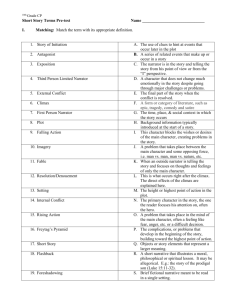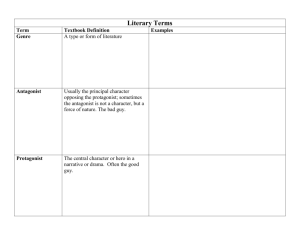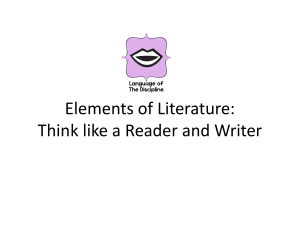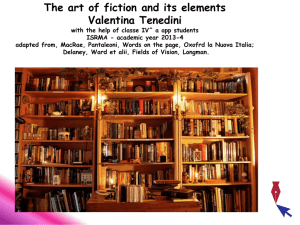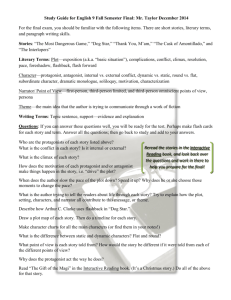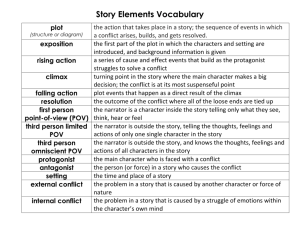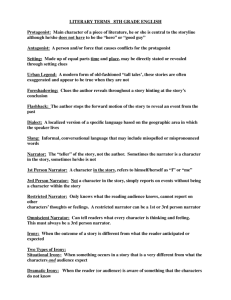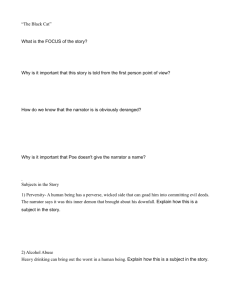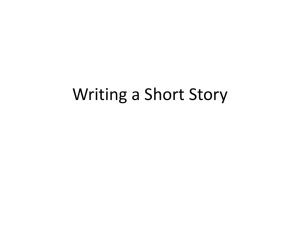English 101 Introduction
advertisement
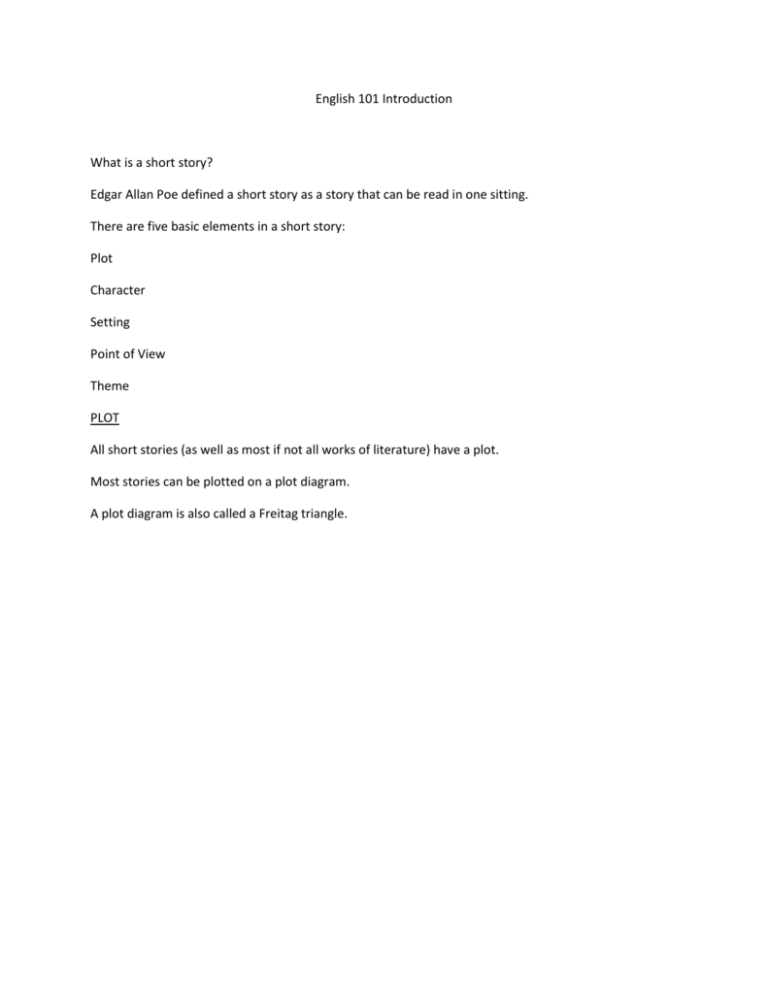
English 101 Introduction What is a short story? Edgar Allan Poe defined a short story as a story that can be read in one sitting. There are five basic elements in a short story: Plot Character Setting Point of View Theme PLOT All short stories (as well as most if not all works of literature) have a plot. Most stories can be plotted on a plot diagram. A plot diagram is also called a Freitag triangle. A. Exposition- This is background information the author thinks the reader needs to know. Some stories need very little exposition, i.e. John Updike’s “A&P.” Other stories need a great deal of exposition to assist the reader, i.e. Joseph Conrad’s “Heart of Darkness.” B. Initial Incident- This is the event that gets the action going in the story. Remember “The Interlopers” by Saki from grade nine. C. Rising action- This is usually the longest part of a story. It is where you have the most conflict. There are two types of conflict. a. Internal conflict which takes place inside a character. The majority of Poe’s stories deal with internal conflict. b. External conflict which takes place between two or more characters or between a character(s) and nature. Think “The Most Dangerous Game” and “The Interlopers.” D. Climax- This is the moment of crisis in the story. It marks the end of major action in the story. E. Falling Action- This is where the author begins to wrap up the story. F. Denouement- This is a French word that means the untangling of the knot. The author wraps up the storyline. Not all stories fit into a neat package at the end. Some of them will have twists in their ending, for example, “The Necklace” and “The Gift of the Magi” by O. Henry. Foreshadowing is when the author gives you a hint as to what is coming up in a story. Many stories use this technique. Flashback is when the author through a character looks back at events that have already occurred. Ernest Hemingway’s “The Short Happy Life of Francis Macomber” and William Faulkner’s “A Rose for Emily” use flashback effectively. CHARACTER When you read, you care most about finding convincing portrayals of human nature in action. We care about the characters before we care about what happens to them. Characterization is the method by which writers create, reveal, and develop characters. Writers focus on the complexity, contradictions, and difficulties in a person’s life and personality. Protagonist is the central character. The reader usually learns more about this character. Dynamic characters go through some type of development in story. Static characters remain relatively unchanged. Round characters have complex personalities that may defy simple analysis or descrption. Flat characters lack depth. A stereotype character is a type of flat character. Think Otis the town drunk on The Andy Griffith Show. Writers develop characters in a number of ways. When using external reality, writers describe their physical appearance, dramatize their actions and conversations, and summarize their histories. Hemingway uses this with Francis Macomber and the other characters in that story. When using inner reality, the reader is made aware of a character’s thoughts and feelings. Poe uses this in the majority of his works. Motivation is important in developing a character. Readers do need an explanation for a character’s behavior. Symbolism is when something stands for something else. The longer the work the more characters in the work. Willing suspension of disbelief believes what you are reading is happening as you read it. SETTING Setting is the place, time, and social reality within which a story takes place. Some stories do not rely on setting like Shirley Jackson’s “The Lottery.” Others like the stories by Hemingway, Faulkner, and Flannery O’Connor do rely on setting for their works. When place is an important element of setting, the author usually provides specific, sometimes extended, details of that place. The novel Let Us Now Praise Famous Men is a great example of this. The woods in Nathaniel Hawthorne’s short story “Young Goodman Brown” is also a setting where place is important. The time period a story is set can be significant in a story. Again in the Hawthorne story, we have to know that we are in New England in the time of the Puritans if we are to understand the events in the story, the outlook, and the motivation for the central character. Social context is when a story is the results of the time and place when the story was written. “The Story of an Hour” by Kate Chopin and Uncle Tom’s Cabin by Harriet Beecher Stowe are examples of this. Tone is the attitude an author has toward his subject or audience. A reader can also find symbolism in the setting of a story. POINT OF VIEW Point of view is the perspective from which the reader will view events in a story. There are four type of point of view. First person is when someone in the story is telling the story, i.e. Poe’s stories, F. Scott Fitzgerald’s The Great Gatsby. Second person or objective narrator is when the narrator is removed from the action in a story. He is telling the reader what is happening without commentary, i.e. “A Rose for Emily.” Third person limited is when a narrator is inside the mind of the protagonist. The narrator sees, hears, and knows everything the protagonist knows, i.e. “The Secret Life of Walter Mitty” by James Thurber. Third person omniscient is when a narrator knows everything about everybody in a story. i.e. “The Interlopers” by Saki. THEME Theme is the central and unifying idea about human experience that grows out of a story. Dramatic irony is when the audience knows more than a character in a story, i.e. Romeo and Juliet. Situational irony is when the actual outcome and the expected outcome are different, i.e. “The Necklace” and “The Gift of the Magi.” Verbal irony is what a character says is different than what a character means. Allusion is a reference to another work of literature of history. The three most likely sources of literary allusions are Greek mythology, the Bible, and works of William Shakespeare. Denotation is the dictionary meaning of a word. Connotation is the extended or implied meaning of a word. GUIDELINE FOR READING A SHORT STORY 1. 2. 3. 4. Pay close attention to the title. Ask yourself what you know about the author. Take notes, physical or mental, about elements in a story you think are important. Keep asking questions as you read.

